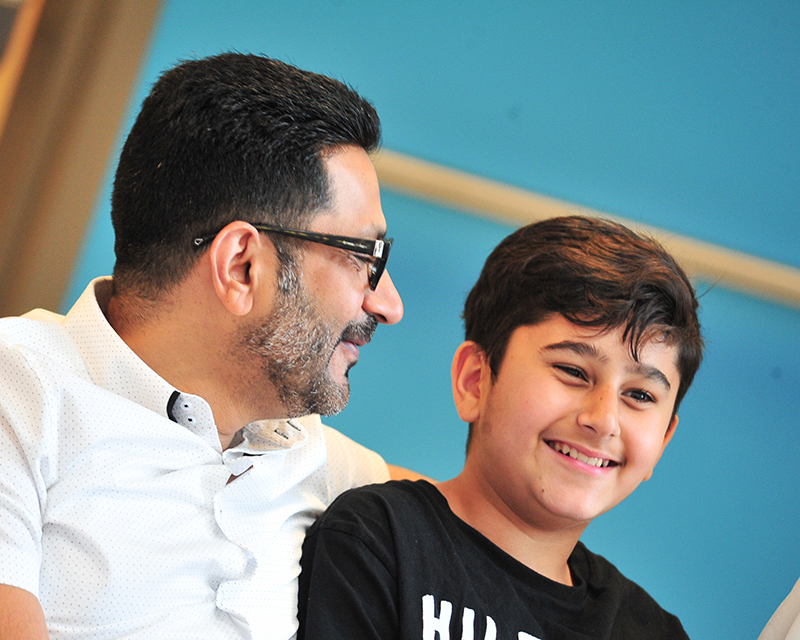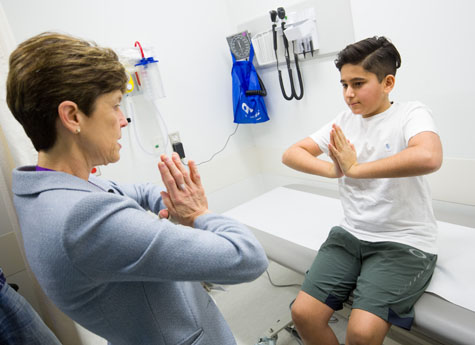Research is the only hope
Thursday, October 26, 2017
Kids are 25% of the population. Yet they get
10%
of research funding.
Although children account for 25% of the population, only 10% of research funding goes to child health. But the next ten years will see more advances in healthcare than the last century combined.
With government research dollars dwindling, each philanthropic dollar you give serves as a springboard and can attract 7 to 10 additional dollars in public funding to help families for whom research is their only hope. Support these families today.
From a wheelchair to walking again
12-year old Mustafa thrives thanks to expert care from the Montreal Children’s Hospital Rheumatology Department
When Mustafa and his family immigrated to Canada from Pakistan in August of 2014, he couldn’t wait to learn how to skate so that he could partake in his new country’s beloved pastime: hockey. As soon as winter came, he headed to his local skating rink in Kirkland and gave it his very best. But as every first-time skater can attest, it wasn’t easy to stay on his skates. “He was learning, so he ended up falling a lot,” says his mother Nadia. That was when he first started complaining of wrist pain, she explains, that would creep back up with no explanation.
Summer came, and with his wrist pain gone, Mustafa was back to playing all the other sports he loved like golf and squash.” But when winter rolled around again in 2016 and he laced up his skates, “again, he started complaining about his wrist,” says Nadia. “We were confused about it. The problem seemed to come and go, and sometimes his wrist would swell, and then it would go away.”
 Just a few months later, when Mustafa was in gym class, the symptoms took on a whole new level of concern. “Mustafa’s gym teacher was showing the students how to do a proper push up, and he just couldn’t bend his wrist into position. That’s when I started to get really scared,” says Nadia.
Just a few months later, when Mustafa was in gym class, the symptoms took on a whole new level of concern. “Mustafa’s gym teacher was showing the students how to do a proper push up, and he just couldn’t bend his wrist into position. That’s when I started to get really scared,” says Nadia.
Searching for the unknown
Just a month after his symptoms started worsening, Mustafa woke up one morning with bruises on his palm, and an extremely swollen hand. Nadia rushed to the Montreal Children’s Hospital Emergency Room to get answers. The team evaluated him and confirmed Mustafa was dealing with something serious. The family was immediately scheduled for an appointment in the Pediatric Day Centre the next day, where they met with pediatric rheumatologist Dr. Claire LeBlanc who ran a series of tests to determine the cause of his inflammation. It was determined that Mustafa had a type of juvenile idiopathic arthritis called enthesitis-related arthritis or ERA.
“It was tough to determine which kind of arthritis he had initially because the symptoms he presented with were not characteristic,” says Dr. LeBlanc, who explains that patients with ERA rarely complain of wrist pain but more frequently of pain in the lower limbs. “In patients with ERA, what we see is that the inflammation attacks the joints but also where tendons or ligaments attach to bone. What we noticed in Mustafa shortly after his diagnosis was that he started to develop enthesitis in his heel, which really impeded his ability to walk.”
Finding the right treatment
In order to relieve his pain, Dr. LeBlanc began treating Mustafa with ultrasound guided steroid injections in the affected joints. “We found that he did get a bit better for a short time, but it didn’t fix the problem – his heel remained inflamed and he still couldn’t walk well at all,” she explains. “We tried other non-steroidal anti-inflammatory medications, but these proved not to be successful either because of the aggressive nature of his disease. We usually prescribe another medication called methotrexate at this point, but his enthesitis was so severe it was not likely to respond.”
 Given that Mustafa was such an active and energetic young boy who would soon be starting another school year, Dr. LeBlanc started discussing the idea of using a biologic medication to treat the inflammation that was causing him so much pain. “Biologic medications are developed to target specific molecules that cause inflammation,” she explains, “but there are significant hurdles to cross before using them.”
Given that Mustafa was such an active and energetic young boy who would soon be starting another school year, Dr. LeBlanc started discussing the idea of using a biologic medication to treat the inflammation that was causing him so much pain. “Biologic medications are developed to target specific molecules that cause inflammation,” she explains, “but there are significant hurdles to cross before using them.”
For one, Mustafa’s parents would have to be in agreement about treating their son with a medication that could take time to show results and could have side effects. The second hurdle was getting the family’s insurance company to agree to authorize the treatment and agree to cover payment of the drug. “After discussing it with Mustafa’s parents, they agreed to go forward with the request for this treatment from their insurance company,” says Dr. LeBlanc. “I wrote to the company to ask them to allow Mustafa to be approved for the drug, citing the fact that he had had very little response with standard therapies and that he was experiencing horrible pain, limiting his ability to walk.”
To everyone’s delight, the insurance company agreed to approve and pay for the biologic treatment. “On August 27th, Mustafa received his first dose of the new treatment,” says Nadia. “Dr. LeBlanc told us that it can sometimes take the body up to a month to respond. But the very next day, Mustafa came down the stairs from his room and he was totally different! He was walking 60% better than before. I couldn’t believe it!”
Physiotherapist Michèle Geoffrion, who saw Mustafa a few months after he began his biologic treatment, says it was like seeing a different patient when she saw him during a follow-up visit in January 2017. “When I saw him in May 2016, his legs were tight, he was in a lot of pain and he could barely walk. Seeing him again was like seeing a new patient – he seemed a lot more relaxed now that he was no longer in pain, he was smiling and chatty.”
Sophie Laniel, Mustafa’s occupational therapist, says his recovery has been very impressive to watch. “He never gave up, he always followed my recommendations, and to see how far he has come is just factastic,” she says.
Returning to a normal pain-free life
Today, Mustafa is back to enjoying the sports he loves and recently was awarded a scholarship for high school at Kuper Aacademy, where he will graduate from grade 6 this summer. Nadia says her son is nearly 100% better since he was administered the biologic treatment and considers his recovery a true miracle. “We are so thankful to Dr. LeBlanc and the entire rheumatology team for everything they have done for Mustafa,” she says. “When I first moved to Canada, away from all of our family, I used to wonder about why my journey brought me here. I now know that it was because Mustafa was meant to be treated in a place where people care so much and we are so thankful for everything the Children’s has done for us. We always tell Mustafa that we want him to continue to do well in school because he can be a future Dr. LeBlanc.”